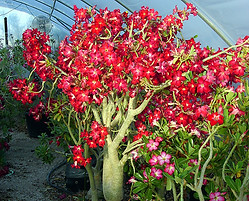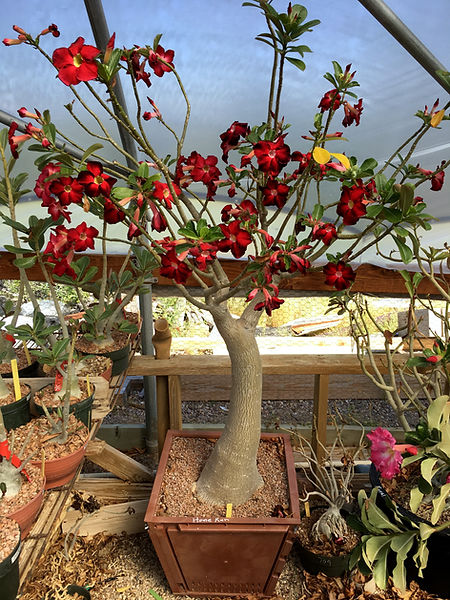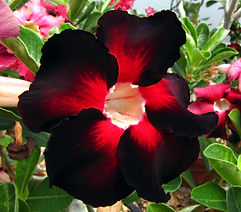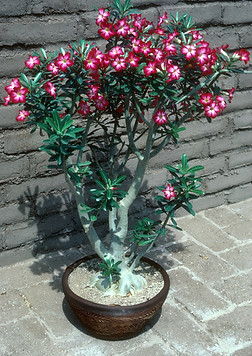An Adenium Website
_edited.png)
_edited_edited.png)
_edited.png)
_edited_edited.png)
'Amiability'
Parentage: Adenium "obesum"
Creator: Received from Ming Huey Chen, Taiwan, with note: "Ming Huey #7, long-time favorite Taiwan Red strain. Looks like 'Daeng Nabanant, but much more vigorous. "
Plant form: A sturdy, erect shrub, taller than wide, with large bright green leaves. Tends to be evergreen. Plant at right is 7 years old on a graft, about 3 feet x 2 feet.
Flower: Round, 105 mm diameter x 50 mm petal width. Petals bright red with almost no fading near throat. Petals often have a narrow black edge in mild weather. Throat white with no nectar guides. Blooms mostly in spring and fall.
Notes: As described above, this is an early member of the Taiwan Red strain, distinguished by their large bright green leaves and impressively big, bright red flowers. This clone's stems are unusually sturdy for the species.



Left: Under ideal conditions, new flowers of 'Amiability' have a black edge, which fades with age as shown in the inflorescence at right.

Above and below: A greenhouse full of 'Arrogant' at T.W. Lee's nursery in Taiwan.
'Arrogant'
Parentage: Adenium "obesum"
Creator: Unknown, Taiwan; widely produced by 2008.
Plant form: A spreading shrub with small caudex when grown on own roots. Large bright green leaves, evergreen. Stems fairly sturdy for the species.
Flower: Round, very large, 95 mm diameter x 41 mm petal width. Petals deep velvety red, with black margin in mild weather; almost no fading toward throat. Throat white or yellowish with faint nectar guides.
Notes: This clone is one of the early members of the Taiwan Red strain, distinguished by their large bright green leaves and impressively big, bright red flowers. The cv. name 'Arrogant' is a literal translation of the Chinese name Chien Jiao (?); a better translation would be something like "Charming".


Above: a flower of 'Arrogant' at its best.
'Big Mama'
Parentage: Adenium "obesum"
Creator: unknown
Plant form: Giant shrub with massive caudex (swollen roots), much larger than is typical of the species.
Flower: Small, star-shaped, petals have pink edge (closeup is oversaturated) with light pink interior, bright yellow throat with faint nectar guides.
Notes:


John Lucas formerly of Tradewinds South Nursery in Florida, pollinating 'Big Mama' in 1999. Photos: Walter Michot.


'(Double) Black Asia'
Parentage: Adenium "obesum"
Creator: ?
Plant form: Very weak stems can't support the heavy flowers; needs regular pruning.
Flower: Fully double (flore pleno); in mild weather the petals are saturated dark red with sharp black edges. In hot weather or with age flowers are solid medium-red. The flowers often fail to open because the numerous petals get stuck.
Notes: It isn't clear whether the cv. name should include "double".
Right: The stems of this cv. are too weak to support the flowers.

'Black Ruby'
Parentage: Adenium "obesum"
Creator/Origin: Discovered in a Florida nursery by James Georgusis and introduced by John Lucas of Tradewinds South Nursery in the early 1990s.
Plant form: Medium-sized shrub with an unusually well-developed conical caudex for this species; stems typically weak.
Flower: Semi-star-shaped, 83 mm diameter x 31 mm wide petals; petals deep red with sharp black margins; white throat with no nectar guides. In very hot weather the black margin does not develop and the flowers are medium-red. Blooms profusely in spring and sporadically at other seasons.
Notes: This is one of the first bright red-flowered adeniums to appear in the USA. The plant looks like it may be of the Taiwan Red strain, but its origin has not been traced. It is the parent of numerous early hybrids.


Above left: 'Black Ruby' in full bloom. The grafted plant is about 8 years old. Above right: A four-year-old cutting already has a good conical caudex.


Above left: A new flower of 'Black Ruby' in perfect condition. Above right: In hot weather or with age the flowers lose the black edge.

'Daeng Siam'
Parentage: Adenium "obesum"
Creator: Unknown; probably originated in Taiwan, where almost all adenium breeders were at the time. I found it at Somsak's nursery in Bangkok in 2000.
Plant form: Medium-sized, spreading shrub with modest caudex. Tends to be evergreen.
Flower: Round, 88 mm diameter x 33 mm petal width. New flowers are red with narrow purple margins, fading in a week to rich pink with lavender margins. Throat yellowish to white with no nectar guides. Blooms profusely in spring with a lesser flush in autumn.
Notes: When I found this plant in 2000, the vendors were excited to promote the "new color". But I found almost identical plants under different names at other nurseries and in other countries, including Champoo Taiwan, Optimize, Red Sang Ped, and Daeng Saeng Petch. I also found a pure red "obesum" in Thailand named Daeng Siam. Whatever this clone is called, even better bicolors are available today. For example, see 'Royal Robe'.
Above: This four-year-old cutting of 'Daeng Siam' is about two feet tall and wide in a 14-inch pot.

Near-right: A new flower of 'Daeng Siam' in perfect condition. Far right: An inflorescence showing color change with age.

'Golden Sun'
Parentage: Adenium "obesum"
Creator: Unknown, Taiwan before 2008.
Plant form: Known only on grafts, it's a medium-sized shrub with very weak stems.
Flower: Quite large, round: 97 mm diameter x 45 mm petal width. Petals white with broad deep red margin. Throat white with a few prominent nectar guides.
Notes: There were already several cultivars with very similar flowers by 2008, and all that I saw had weak stems. This is pure A. "obesum", not A. multiflorum, because it blooms during the warm season while in leaf. Some vendors erroneously sell such plants with picoteed flowers as multiflorum.


Above: Adeniums with red-picoteed flowers are sometimes confused with A. multiflorum. But flowering in during the growing season with leaves is proof that they are A. "obesum".

Above: Five-year-old Adenium 'Great General' grafted onto a sturdy rootstock. Plant is about two feet high and three feet wide in a 14-inch pot.
'Great General'
Parentage: Adenium "obesum"
Creator: C.F. Chang, Taiwan, before 2008.
Plant form: A large, vigorous, spreading to drooping shrub. Sold only as grafted plants; on its own roots it's a weak grower with almost no caudex. The stems are weak and need pruning every few years to maintain an attractive shape.
Flower: Huge, round to nearly circular (if the petals were not ruffled), 98 mm diameter x 46 mm petal width. Petals intense crimson with almost no fading toward the throat. Throat pure white with no nectar guides. Blooms profusely in spring.
Notes: This cv. is outstanding for more than its huge almost 4-inch flowers. It's a natural tetraploid "obesum", the only one that I've encountered. It can therefore hybridize with the naturally 4n species A. "arabicum" and its 4n interspecific hybrids. The offspring are often very large plants with huge deep red flowers; but the stems and caudexes still need improvement.

Above: The magnificent flower of 'Great General'.
Parentage: Adenium "obesum"
Origin: Wild origin.
Plant form: Medium-sized, fairly erect shrub with small caudex.
Flower: Star-shaped, 65 mm diameter x 18 mm petal width. Petals pure white; throat white with no nectar guides. Blooms mostly in spring.
Notes: Ken Oulton of Malindi, Kenya collected it. Tom Grumbley, also of Malindi, propagated and shared it with Seymour Linden and Gerald Barad in the USA in 1992. They distributed it as 'Grumbley White'. At about the same time an apparently identical plant appeared in Asia called 'Ina White'. Rowley (1999) published the US cv. as 'Snowbell'.
This clone is one of two that probably triggered the surge in adenium popularity that began in the 1990s. Combined with the introduction of 'Crimson Star', it showed Asian growers that adeniums could be had in colors other than the common pink.
This spindly shrub and its small flowers are mediocre by today's standards, but most of the white-flowered A. "obesum" in cultivation are probably descended from 'Grumbley White'.


Above: A 14-year-old cutting of 'Grumbley White' in a 16-inch pot. The stems are thin, but still sturdier than those of most "obesum".
Left: The small flower of 'Grumbley White'. Check out modern white-flowered "obesum" cultivars to see what breeders have created from this humble wild plant.
'La Hong Thong'
NEED PHOTO OF PLANT


Parentage: Adenium "obesum"
Origin: Unknown; already widely available in Bangkok, Thailand in 2000.
Plant form: Medium-sized shrub with fairly sturdy stems and modest caudex. Tends to be evergreen.
Flower: Round, medium-sized, 78 mm diameter x 32 mm petal width; outer 2/3 of petals bright red, fading to white at throat. Throat white with no nectar guides. One of the earliest adeniums to have a high flower count - more than twice the standard of 5 per inflorescence.
Notes: This cv. is indistinguishable from 'Tropical Sun', which was sold in the USA in the early 2000s
'Home Run'
Parentage: A. "obesum"
Creator: Juin Shen Lee, Taiwan, before 2000.
Plant form: Typical for the species: a weak-stemmed shrub with little caudex development. Almost always grafted onto big rootstocks. Large leaves are semi-evergreen.
Flower: very large, 105 mm diameter x 48 mm petal width (4+ inches!). Petal color of newly-opened flowers varies with temperature. The most stunning variant has deep, velvety-red petals with no fading toward the throat, and a black margin. The margin may be narrow, or sometimes the outer halves of the petals are black, feathering into the red lower halves. In hot weather (>100F/38C) the flowers open pure red. In all cases flowers fade to lighter shades as they age. Blooms profusely in spring, often with a smaller flush in autumn.
Notes: This is probably the best of the Taiwan Red strain, distinguished by large bright green leaves and large bright red flowers. The Chinese name is "hon bu zhan", which sounds something like "home run". The name means "better than red".

Left: Note by my host Jung-Sheng Lin (Sinox Horticulture, Kaohsiung) about 'Home Run'.

Above: 'Home Run' grafted onto a 3-foot tall 'Arabian Ruby' caudex.




Above and below: A selection of the flower colors of 'Home Run', which vary greatly with temperature and age.






Above: 'Red Everblomer' has sturdier branches than typical "obesum". Left: a 4-year-old cutting. Right: a much older plant on its own roots, about 6 feet tall.
'Red Everbloomer'
Parentage: Adenium "obesum"
Creator: Dimmitt selection, 1979.
Plant form: Erect, well-branched shrub, with sturdier branches than is typical of the species. Modest caudex in original seedling; cuttings develop massive roots. Tends to be evergreen.
Flower: Semi-star-shaped but with rounded petal tips, 66 mm diameter x 25 mm petal width. Outer halves of petals medium-red, fading to near white at throat. Throat white with no or a few faint nectar guides. Blooms year-round in tropical conditions.
Notes: Selected from a batch of second generation seedlings from four plants purchased from Grigsby Cactus Gardens in the mid 1970s. This was an excellent red at the time when nearly all A. "obesum" had pink flowers. It's useful to compare it with recent cultivars to realize how far adenium breeding has progressed in the 40 years since 1980. This plant is also important as the parent of the first good red-flowered hybrid, 'Crimson Star'.

Left: Compare this humble beginning with today's red-flowered "obesum" selections!
'Red Henny 4n' (aka 'FC-1')
Parentage: Adenium "obesum"
Creator: Richard J. “Jake” Henny, Florida USA, early 2000s
Plant form: A vigorous, spreading shrub with notably thick stems and a modest caudex. Tends to be evergreen.
Flower: round to nearly circular,very large, 90 mm diameter x 46 mm petal width. Petals have a wide red or deep pink margin (paler in hot weather), fading to near-white at throat. Throat yellow with no nectar guides. Blooms repeatedly year round, most heavily in spring.
Notes: This is reportedly the first induced tetraploid, by treating seeds from an ordinary "obesum" with colchicine. (What would result from treating today's superior cultivars?) The original name was FC-1, because Henny verified its tetraploid status by measuring the quantity of DNA with flow cytometry.


A 9-year-old cutting of 'Red Henny (4n)'. Tetraploid plants tend to have sturdier stems than diploids, but this clone still has rather weak stems that should be pruned every few years to maintain a more attractive form. This plant is getting pretty floppy.
Left: The huge and well-shaped flower of 'Red Henny (4n)'. Flowers will be paler in weather above 100 F/38 C.

Above: 'Royal Robe' grows well on its own roots, which develop a pseudocaudex in time. Plant is in a 14-inch pot.
'Royal Robe'
Parentage: Adenium "obesum", ['Saenglasame' x ('Saenglasame' x 'Daeng Siam')]
Creator: Dimmitt, 2001.
Plant form: A large, vigorous, fairly upright shrub that develops massive roots. Nearly evergreen.
Flower: Semi-star-shaped, 70 mm diameter x 30 mm petal width. Petals open deep red with narrow purple margin, aging to light red with lavender margin. Throat light yellow with no nectar guides. Blooms profusely in spring and sporadically the rest of the year.
Notes: There are numerous other beautiful bicolor obesums, including double flowers.


Above: New (left) and older flowers of 'Royal Robe'.
'Snow Lotus'
Parentage: Adenium "obesum"
Creator: C.F. Chang, Taiwan, before 2008.
Plant form: A vigorous large, spreading shrub with lush foliage and a small caudex. Almost always grown on grafts.
Flower: Round, 80 mm diameter x 35 mm petal width. Petals pure white; throat yellow (sometimes greenish) with no nectar guides. Blooms profusely in spring and sporadically the rest of the year.
Notes: There are now many excellent white-flowered cultivars of A. "obesum". Most, perhaps all, are descended from 'Grumbley White'.
NEED PHOTO OF PLANT


Above: The dazzling white flowers of 'Snow Lotus'.
'Tradewinds #20'
Parentage: Adenium "obesum" ('Black Ruby' x 'Ruby 2')
Creator: John Lucas, Tradewinds South Nursery, late 1990s.
Plant form: A medium-sized, erect shrub with massive roots. Evergreen.
Flower: Round, 84 mm diameter x 33 mm petal width. Petals deep crimson with a broad black border, fading only slightly toward throat. Throat white with very faint nectar guides. Prolific bloomer; season unrecorded.
Notes: John Lucas produced a number of superb cultivars in the early days of adenium breeding. I hope this cv. is still in existence; it's a stunner.

Left: the flowers of 'Tradewinds #20' look incandescent. Photo: John Lucas.
Right: 'Tradewinds #20' has massive roots, especially for an "obesum". Photo: John Lucas.

Footnotes
Rowley, Gordon, 1999. Pachypodium and Adenium. The Cactus File Handbook 5. David Neville, series editor. Nuffield Press, Oxford.















